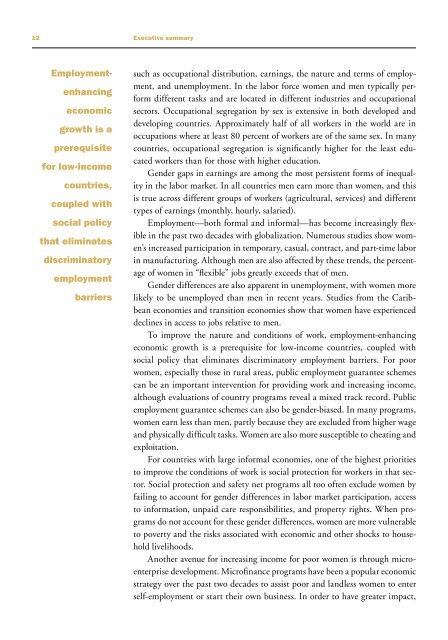Taking action: achieving gender equality and empowering women
Taking action: achieving gender equality and empowering women
Taking action: achieving gender equality and empowering women
Create successful ePaper yourself
Turn your PDF publications into a flip-book with our unique Google optimized e-Paper software.
12 Executive summary<br />
Employmentenhancing<br />
economic<br />
growth is a<br />
prerequisite<br />
for low-income<br />
countries,<br />
coupled with<br />
social policy<br />
that eliminates<br />
discriminatory<br />
employment<br />
barriers<br />
such as occupational distribution, earnings, the nature <strong>and</strong> terms of employment,<br />
<strong>and</strong> unemployment. In the labor force <strong>women</strong> <strong>and</strong> men typically perform<br />
different tasks <strong>and</strong> are located in different industries <strong>and</strong> occupational<br />
sectors. Occupational segregation by sex is extensive in both developed <strong>and</strong><br />
developing countries. Approximately half of all workers in the world are in<br />
occupations where at least 80 percent of workers are of the same sex. In many<br />
countries, occupational segregation is significantly higher for the least educated<br />
workers than for those with higher education.<br />
Gender gaps in earnings are among the most persistent forms of in<strong>equality</strong><br />
in the labor market. In all countries men earn more than <strong>women</strong>, <strong>and</strong> this<br />
is true across different groups of workers (agricultural, services) <strong>and</strong> different<br />
types of earnings (monthly, hourly, salaried).<br />
Employment—both formal <strong>and</strong> informal—has become increasingly flexible<br />
in the past two decades with globalization. Numerous studies show <strong>women</strong>’s<br />
increased participation in temporary, casual, contract, <strong>and</strong> part-time labor<br />
in manufacturing. Although men are also affected by these trends, the percentage<br />
of <strong>women</strong> in “flexible” jobs greatly exceeds that of men.<br />
Gender differences are also apparent in unemployment, with <strong>women</strong> more<br />
likely to be unemployed than men in recent years. Studies from the Caribbean<br />
economies <strong>and</strong> transition economies show that <strong>women</strong> have experienced<br />
declines in access to jobs relative to men.<br />
To improve the nature <strong>and</strong> conditions of work, employment-enhancing<br />
economic growth is a prerequisite for low-income countries, coupled with<br />
social policy that eliminates discriminatory employment barriers. For poor<br />
<strong>women</strong>, especially those in rural areas, public employment guarantee schemes<br />
can be an important intervention for providing work <strong>and</strong> increasing income,<br />
although evaluations of country programs reveal a mixed track record. Public<br />
employment guarantee schemes can also be <strong>gender</strong>-biased. In many programs,<br />
<strong>women</strong> earn less than men, partly because they are excluded from higher wage<br />
<strong>and</strong> physically difficult tasks. Women are also more susceptible to cheating <strong>and</strong><br />
exploitation.<br />
For countries with large informal economies, one of the highest priorities<br />
to improve the conditions of work is social protection for workers in that sector.<br />
Social protection <strong>and</strong> safety net programs all too often exclude <strong>women</strong> by<br />
failing to account for <strong>gender</strong> differences in labor market participation, access<br />
to information, unpaid care responsibilities, <strong>and</strong> property rights. When programs<br />
do not account for these <strong>gender</strong> differences, <strong>women</strong> are more vulnerable<br />
to poverty <strong>and</strong> the risks associated with economic <strong>and</strong> other shocks to household<br />
livelihoods.<br />
Another avenue for increasing income for poor <strong>women</strong> is through microenterprise<br />
development. Microfinance programs have been a popular economic<br />
strategy over the past two decades to assist poor <strong>and</strong> l<strong>and</strong>less <strong>women</strong> to enter<br />
self-employment or start their own business. In order to have greater impact,

















